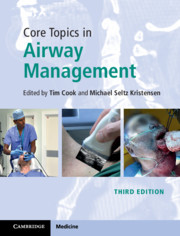Book contents
- Core Topics in Airway Management
- Core Topics in Airway Management
- Copyright page
- Contents
- Contributors
- Foreword
- Preface to the Third Edition
- Section 1 Airway Management: Background and Techniques
- Section 2 Airway Management: Clinical Settings and Subspecialties
- Chapter 22 The Airway in Obstetrics
- Chapter 23 The Paediatric Airway
- Chapter 24 Airway Management in Obesity
- Chapter 25 Maxillofacial and Dental Surgery
- Chapter 26 Ear, Nose and Throat Surgery: Airway Management
- Chapter 27 Lung Separation
- Chapter 28 Airway Management in the Critically Ill
- Chapter 29 The Patient with a Tracheostomy
- Chapter 30 Pre-hospital and Trauma Airway Management
- Chapter 31 Airway Management during CPR
- Chapter 32 The Bloody and Bleeding Airway
- Chapter 33 The Airway in Anaesthesia for Transoral Robotic Surgery
- Section 3 Airway Management: Organisation
- Index
- References
Chapter 26 - Ear, Nose and Throat Surgery: Airway Management
from Section 2 - Airway Management: Clinical Settings and Subspecialties
Published online by Cambridge University Press: 03 October 2020
- Core Topics in Airway Management
- Core Topics in Airway Management
- Copyright page
- Contents
- Contributors
- Foreword
- Preface to the Third Edition
- Section 1 Airway Management: Background and Techniques
- Section 2 Airway Management: Clinical Settings and Subspecialties
- Chapter 22 The Airway in Obstetrics
- Chapter 23 The Paediatric Airway
- Chapter 24 Airway Management in Obesity
- Chapter 25 Maxillofacial and Dental Surgery
- Chapter 26 Ear, Nose and Throat Surgery: Airway Management
- Chapter 27 Lung Separation
- Chapter 28 Airway Management in the Critically Ill
- Chapter 29 The Patient with a Tracheostomy
- Chapter 30 Pre-hospital and Trauma Airway Management
- Chapter 31 Airway Management during CPR
- Chapter 32 The Bloody and Bleeding Airway
- Chapter 33 The Airway in Anaesthesia for Transoral Robotic Surgery
- Section 3 Airway Management: Organisation
- Index
- References
Summary
Patients undergoing ear nose and throat (ENT, otorhinolaryngeal) surgery probably present more airway management challenges than any other branch of surgery. ENT procedures encompass a range of operations varying in duration, severity and complexity from simple short cases such as myringotomy, through to complex resection and reconstructive surgeries for head and neck cancer. In all cases the surgical team operates close to the airway and in many within the airway, which is therefore shared with the anaesthetist. In this chapter, the authors discuss in some depth these challenges and how to address them, airway management and ventilation options and strategies including but not limited to awake intubation, different subtypes of jet ventilation, and high flow nasal oxygenation as well recent advances in the field. They further discuss extubation strategies and controversies as well as a plan to manage commonly encountered complications such as bleeding in the airway. For a successful outcome, these ‘shared airway’ procedures require close communication and cooperation between anaesthetist and surgeon, an understanding of each other’s challenges, knowledge of specialist equipment, and a thorough preoperative evaluation to identify potential risk factors for poor perioperative outcomes.
Keywords
- Type
- Chapter
- Information
- Core Topics in Airway Management , pp. 223 - 242Publisher: Cambridge University PressPrint publication year: 2020



